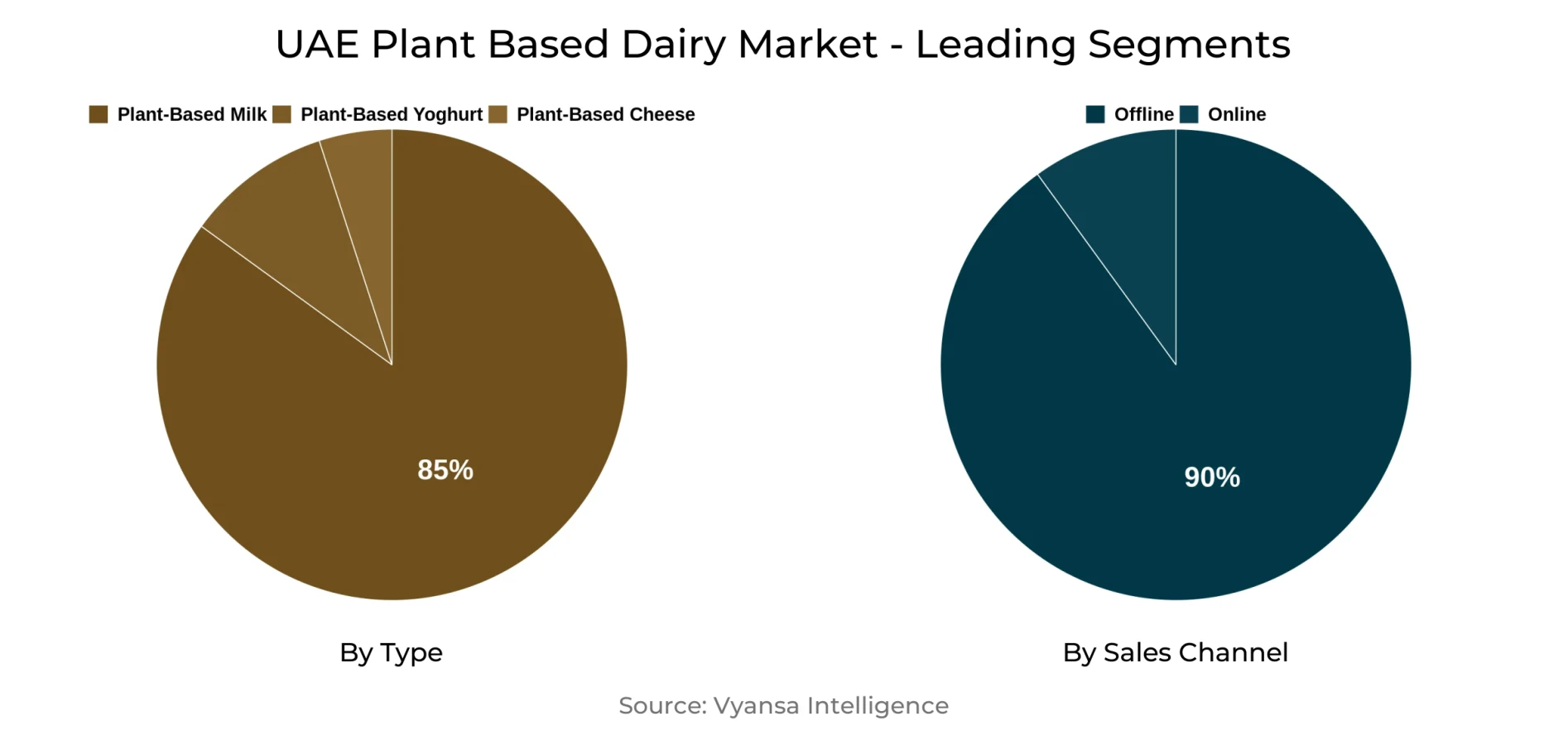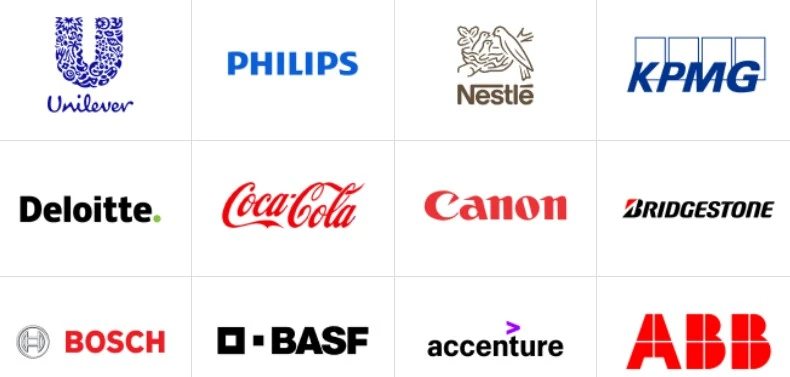UAE Plant-Based Dairy Market Report: Trends, Growth and Forecast (2025-2030)
By Product Type (Plant-Based Milk (Soy Drinks, Almond, Blends, Coconut, Oat, Rice, Other Plant-Based Milk), Plant-Based Yoghurt, Plant-Based Cheese), By Sales Channel (Retail Offline (Grocery Retailers, Convenience Retailers, Supermarkets, Hypermarkets), Retail Online)
- Food & Beverage
- Dec 2025
- VI0026
- 125
-




UAE Plant-Based Dairy Market Statistics, 2025
- Market Size Statistics
- Plant-Based Dairy in UAE is estimated at $ 30 Million.
- The market size is expected to grow to $ 40 Million by 2030.
- Market to register a CAGR of around 4.91% during 2025-30.
- Product Shares
- Plant-Based Milk grabbed market share of 85%.
- Competition
- More than 5 companies are actively engaged in producing Plant-Based Dairy in UAE.
- Top 5 companies acquired 65% of the market share.
- Koita FZE, So Good International Ltd, Ecotone NV, Danone, Groupe, Ace Canning Corp Sdn Bhd etc., are few of the top companies.
- Sales Channel
- Retail Offline grabbed 90% of the market.
UAE Plant-Based Dairy Market Outlook
The UAE plant-based dairy market is poised to register constant growth over 2025–30, bolstered by growing health and wellness trends. While traditional dairy continues to lead, there is a niche consumers who are migrating towards plant-based due to perceived benefits like increased vitamin and protein levels, reduced saturated fat, and less allergy issues.
Soy, almond, and oat milk are at present the most sought-after alternatives, and oat milk is leading the charge in foodservice demand, particularly in smoothies and coffee. All the products are generally available in contemporary grocery retailers, although they still represent a modest fraction of the entire dairy market.
Millennials and Generation Z are leading this trend. Their preference for health, sustainability, and being green is stimulating more interest in plant-based alternatives. Moreover, increased dairy intolerance among millennials is further fuelling the use of plant-based milk.
While growth opportunities exist, there is still a big obstacle to more extensive adoption in the form of high prices. Plant-based dairy is predominantly accessible in high-end stores such as Spinneys and Waitrose and less so in discounters. Coffee shops also add a surcharge for plant-based milk, perpetuating its premium status. Market leaders include brands like Alpro, Koita, Saba, Essentially, and Tres Marias Coffee Company. Significantly, Tres Marias won Costa Coffee the UAE-wide exclusive supply agreement for plant-based milk in 2024. Ongoing backing from vegan groups and an increase in flexitarianism will help increase demand. Yet, because of price, market penetration will expand slowly, and pricing tactics will be important to long-term success.

UAE Plant-Based Dairy Market Growth Driver
The increasing health and wellness consciousness of consumers in the UAE is contributing significantly to the consumption of plant-based dairy. Although conventional dairy continues to be well accepted, there is a niche group of consumers who are actively switching to plant-based dairy alternatives. This change is attributed mainly to the perception that such foods are richer in vitamins and protein, poorer in saturated fat and carbohydrates, and less likely to cause allergic reactions in people with dairy intolerance.
Though it has potential, plant-based dairy currently maintains a relatively minor percentage in the total market. Soy beverages, almond milk, and oat milk are still the most sought-after types, primarily sold at modern grocery stores. What is fascinating is that oat milk is picking up greater momentum in the foodservice segment, particularly due to its application in coffee and smoothies, which is also driving the growth of plant-based among the nation's consumers.
UAE Plant-Based Dairy Market Trend
Increased vegan awareness will likely drive the demand for plant-based dairy in the UAE positively during 2025–30. Though flexitarians are the current market leaders for consuming plant-based dairy products, increasingly, there is a thrust from several plant-based players and organisations pushing consumers towards embracing a completely vegan lifestyle.
Middle East Vegan Society, for example, still hosts events and markets to raise awareness of the advantages of vegan diets. This activity is intended to change consumer demand to favor vegan options, which would influence demand for plant-based milk alternatives over the next few years. As more become aware of the health and ethical advantages of a plant-based lifestyle, the market is bound to pick up even more.
UAE Plant-Based Dairy Market Opportunity
Younger customers, particularly Gen Z, are emerging as the major target segment for plant-based alternatives because of the high value these consumers place on health and sustainability. This age group is in many cases proactively looking to decrease the environmental footprint of the dairy industry, which is fueling demand for plant-based milk. This audience, while presently niche, is growing consistently and is a principal driver of market demand.
Parallelly, increasing instances of dairy intolerance among millennials are also fueling this trend. These customers are opting for plant-based dairy alternatives, which are promoted on health grounds such as enhanced digestion and reduced sugar consumption, as well as sustainability. Both Generation Z and millennials are strongly attracted to these values since they are more and more looking into alternative products such as plant-based milk—usually found near the conventional shelf-stable milk in UAE grocery stores.
| Report Coverage | Details |
|---|---|
| Market Forecast | 2025-30 |
| USD Value 2024 | $ 30 Million |
| USD Value 2030 | $ 40 Million |
| CAGR 2025-2030 | 4.91% |
| Largest Category | Plant-Based Milk segment leads with 85% market share |
| Top Drivers | Health & Wellness Trend Encouraging Shift Toward Plant-Based Options |
| Top Trends | Growing Vegan Awareness to Boost Plant-Based Dairy Adoption |
| Top Opportunities | Rising Preference Among Younger Consumers to Accelerate Demand |
| Key Players | Koita FZE, So Good International Ltd, Ecotone NV, Danone, Groupe, Ace Canning Corp Sdn Bhd, Green Spot Co Ltd, Oatly AB, Al Accad C&G Trading Est and Others. |
UAE Plant-Based Dairy Market Segmentation Analysis

The most leading market segment in the UAE Plant-Based Dairy Market in 2025-30 will be plant-based milk. The primary reason for this is the increasing accessibility of popular varieties such as almond, coconut, soy, and particularly oat milk. Oat milk is particularly known for being neutral-tasting, which makes it a favorite to be mixed into tea or coffee. Yet, the premium retail price of these items is still an issue since investments in R&D and procurement are still at the nascent stage. Plant-based milk is currently two to three times more costly than local dairy milk.
Even with increasing competition among plant-based milk brands, no price reductions have been witnessed so far, and inflationary pressures mean they are not likely in the foreseeable future. Although these premium prices hinder broader consumer uptake, brands with intelligent pricing options may gain long-term loyalty from customers. However, robust retail volume growth is anticipated, albeit from a relatively low base.
Top Companies in UAE Plant-Based Dairy Market
The top companies operating in the market include Koita FZE, So Good International Ltd, Ecotone NV, Danone, Groupe, Ace Canning Corp Sdn Bhd, Green Spot Co Ltd, Oatly AB, Al Accad C&G Trading Est, etc., are the top players operating in the UAE Plant-Based Dairy Market.
Frequently Asked Questions
Related Report
1. Market Segmentation
1.1. Research Scope
1.2. Research Methodology
1.3. Definitions and Assumptions
2. Executive Summary
3. UAE Plant Based Dairy Market Policies, Regulations, and Standards
4. UAE Plant Based Dairy Market Dynamics
4.1. Growth Factors
4.2. Challenges
4.3. Trends
4.4. Opportunities
5. UAE Plant Based Dairy Market Statistics, 2020-2030F
5.1. Market Size & Growth Outlook
5.1.1.By Revenues in US$ Million
5.2. Market Segmentation & Growth Outlook
5.2.1.By Type
5.2.1.1. Plant-Based Milk- Market Insights and Forecast 2020-2030, USD Million
5.2.1.1.1. Soy Drinks- Market Insights and Forecast 2020-2030, USD Million
5.2.1.1.2. Almond- Market Insights and Forecast 2020-2030, USD Million
5.2.1.1.3. Blends- Market Insights and Forecast 2020-2030, USD Million
5.2.1.1.4. Coconut- Market Insights and Forecast 2020-2030, USD Million
5.2.1.1.5. Oat- Market Insights and Forecast 2020-2030, USD Million
5.2.1.1.6. Rice- Market Insights and Forecast 2020-2030, USD Million
5.2.1.1.7. Other Plant-Based Milk- Market Insights and Forecast 2020-2030, USD Million
5.2.1.2. Plant-Based Yoghurt- Market Insights and Forecast 2020-2030, USD Million
5.2.1.3. Plant-Based Cheese- Market Insights and Forecast 2020-2030, USD Million
5.2.2.By Sales Channel
5.2.2.1. Offline- Market Insights and Forecast 2020-2030, USD Million
5.2.2.1.1. Grocery Retailers- Market Insights and Forecast 2020-2030, USD Million
5.2.2.1.1.1. Convenience Retailers- Market Insights and Forecast 2020-2030, USD Million
5.2.2.1.1.2. Supermarkets- Market Insights and Forecast 2020-2030, USD Million
5.2.2.1.1.3. Hypermarkets- Market Insights and Forecast 2020-2030, USD Million
5.2.2.2. Online- Market Insights and Forecast 2020-2030, USD Million
5.2.3.By Competitors
5.2.3.1. Competition Characteristics
5.2.3.2. Market Share & Analysis
6. UAE Plant-Based Milk Market Outlook, 2020-2030F
6.1. Market Size & Growth Outlook
6.1.1.By Revenues in US$ Million
6.2. Market Segmentation & Growth Outlook
6.2.1.By Sales Channel- Market Insights and Forecast 2020-2030, USD Million
7. UAE Plant-Based Yoghurt Market Outlook, 2020-2030F
7.1. Market Size & Growth Outlook
7.1.1.By Revenues in US$ Million
7.2. Market Segmentation & Growth Outlook
7.2.1.By Sales Channel- Market Insights and Forecast 2020-2030, USD Million
8. UAE Plant-Based Cheese Market Outlook, 2020-2030F
8.1. Market Size & Growth Outlook
8.1.1.By Revenues in US$ Million
8.2. Market Segmentation & Growth Outlook
8.2.1.By Sales Channel- Market Insights and Forecast 2020-2030, USD Million
9. Competitive Outlook
9.1. Company Profiles
9.1.1.Danone
9.1.1.1. Business Description
9.1.1.2. Product Portfolio
9.1.1.3. Collaborations & Alliances
9.1.1.4. Recent Developments
9.1.1.5. Financial Details
9.1.1.6. Others
9.1.2.Ace Canning Corp Sdn Bhd
9.1.2.1. Business Description
9.1.2.2. Product Portfolio
9.1.2.3. Collaborations & Alliances
9.1.2.4. Recent Developments
9.1.2.5. Financial Details
9.1.2.6. Others
9.1.3.Green Spot Co Ltd
9.1.3.1. Business Description
9.1.3.2. Product Portfolio
9.1.3.3. Collaborations & Alliances
9.1.3.4. Recent Developments
9.1.3.5. Financial Details
9.1.3.6. Others
9.1.4.Oatly AB
9.1.4.1. Business Description
9.1.4.2. Product Portfolio
9.1.4.3. Collaborations & Alliances
9.1.4.4. Recent Developments
9.1.4.5. Financial Details
9.1.4.6. Others
9.1.5.Al Accad C&G Trading Est
9.1.5.1. Business Description
9.1.5.2. Product Portfolio
9.1.5.3. Collaborations & Alliances
9.1.5.4. Recent Developments
9.1.5.5. Financial Details
9.1.5.6. Others
9.1.6.Koita FZE
9.1.6.1. Business Description
9.1.6.2. Product Portfolio
9.1.6.3. Collaborations & Alliances
9.1.6.4. Recent Developments
9.1.6.5. Financial Details
9.1.6.6. Others
9.1.7.So Good International Ltd
9.1.7.1. Business Description
9.1.7.2. Product Portfolio
9.1.7.3. Collaborations & Alliances
9.1.7.4. Recent Developments
9.1.7.5. Financial Details
9.1.7.6. Others
9.1.8.Ecotone NV
9.1.8.1. Business Description
9.1.8.2. Product Portfolio
9.1.8.3. Collaborations & Alliances
9.1.8.4. Recent Developments
9.1.8.5. Financial Details
9.1.8.6. Others
10. Disclaimer
| Segment | Sub-Segment |
|---|---|
| By Product Type |
|
| By Sales Channel |
|
Research Methodology
This study followed a structured approach comprising four key phases to assess the size and scope of the electro-oxidation market. The process began with thorough secondary research to collect data on the target market, related markets, and broader industry context. These findings, along with preliminary assumptions and estimates, were then validated through extensive primary research involving industry experts from across the value chain. To calculate the overall market size, both top-down and bottom-up methodologies were employed. Finally, market segmentation and data triangulation techniques were applied to refine and validate segment-level estimations.
Secondary Research
The secondary research phase involved gathering data from a wide range of credible and published sources. This step helped in identifying industry trends, defining market segmentation, and understanding the market landscape and value chain.
Sources consulted during this phase included:
- Company annual reports, investor presentations, and press releases
- Industry white papers and certified publications
- Trade directories and market-recognized databases
- Articles from authoritative authors and reputable journals
- Gold and silver standard websites
Secondary research was critical in mapping out the industry's value chain and monetary flow, identifying key market segments, understanding regional variations, and tracking significant industry developments.
Other key sources:
- Financial disclosures
- Industry associations and trade bodies
- News outlets and business magazines
- Academic journals and research studies
- Paid industry databases
Primary Research
To validate secondary data and gain deeper market insights, primary research was conducted with key stakeholders across both the supply and demand sides of the market.
On the demand side, participants included decision-makers and influencers from end-user industries—such as CIOs, CTOs, and CSOs—who provided first-hand perspectives on market needs, product usage, and future expectations.
On the supply side, interviews were conducted with manufacturers, industry associations, and institutional participants to gather insights into current offerings, product pipelines, and market challenges.
Primary interviews provided critical inputs such as:
- Market size and revenue data
- Product and service breakdowns
- Market forecasts
- Regional and application-specific trends
Stakeholders consulted included:
- Leading OEM and solution providers
- Channel and distribution partners
- End users across various applications
- Independent consultants and industry specialists
Market Size Estimation and Data Triangulation
- Identifying Key Market Participants (Secondary Research)
- Goal: To identify the major players or companies in the target market. This typically involves using publicly available data sources such as industry reports, market research publications, and financial statements of companies.
- Tools: Reports from firms like Gartner, Forrester, Euromonitor, Statista, IBISWorld, and others. Public financial statements, news articles, and press releases from top market players.
- Extracting Earnings of Key Market Participants
- Goal: To estimate the earnings generated from the product or service being analyzed. This step helps in understanding the revenue potential of each market player in a specific geography.
- Methods: Earnings data can be gathered from:
- Publicly available financial reports (for listed companies).
- Interviews and primary data sources from professionals, such as Directors, VPs, SVPs, etc. This is especially useful for understanding more nuanced, internal data that isn't publicly disclosed.
- Annual reports and investor presentations of key players.
- Data Collation and Development of a Relevant Data Model
- Goal: To collate inputs from both primary and secondary sources into a structured, data-driven model for market estimation. This model will incorporate key market KPIs and any independent variables relevant to the market.
- Key KPIs: These could include:
- Market size, growth rate, and demand drivers.
- Industry-specific metrics like market share, average revenue per customer (ARPC), or average deal size.
- External variables, such as economic growth rates, inflation rates, or commodity prices, that could affect the market.
- Data Modeling: Based on this data, the market forecasts are developed for the next 5 years. A combination of trend analysis, scenario modeling, and statistical regression might be used to generate projections.
- Scenario Analysis
- Goal: To test different assumptions and validate how sensitive the market is to changes in key variables (e.g., market demand, regulatory changes, technological disruptions).
- Types of Scenarios:
- Base Case: Based on current assumptions and historical data.
- Best-Case Scenario: Assuming favorable market conditions, regulatory environments, and technological advancements.
- Worst-Case Scenario: Accounting for adverse factors, such as economic downturns, stricter regulations, or unexpected disruptions.
Partnering With Industry Leaders to Drive Growth
Our mission is to deliver intelligence that matters. By combining data, analysis, and industry expertise, we enable organizations to make smarter, faster, and more impactful decisions. Whether it’s a Fortune 500 company or a high-growth startup, businesses trust us to provide clarity in an ever-evolving marketplace.






